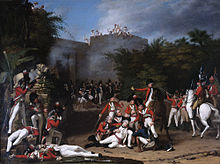Nedumkotta
Nedumkotta or the Travancore lines was a wall built as a protection against consistent invasions from Mysore during the (de facto) rule of Tipu Sultan.It was built by the Dharma Raja Karthika Thirunal (d.A D 1764), King of Travancore, with the request, support and permission of the Kingdom of Kochi.[2] The construction of Nedumkotta or the Travancore Lines is considered to be a unique and unparallel episode in Indian History by historians.[3] The Nedumkotta was a defence fortification constructed along the northern borders of the erstwhile Travancore allied Cochin State of 1757–1762 AD.There were underground cells to store gunpowder and other war materials, special chambers for soldiers to live, and look-outs and mounted field-guns all along the fortification.Two regiments under Captain Knox were stationed near Ayacotta for the first time and Mr. George Powney, a Civil Officer, was sent as an agent of the Company to the Travancore Court.Today there is no physical evidence of the historic Nedumkotta in the form of even ruins anywhere in the Chalakudy taluk-Konoor (Koratty Kizhakkummuri), Muringoor Thekkummury, Kadukutty, Kuruvilassery, Pallipuram and Poyya- through which it passed.It started from Pallipuram Kotta near the sea, touches Kottamukku, Krishnankotta and extended till the Foot hills of the Anamalai in the Western Ghats.[10] By morning Sultan had come three miles in the inner side with his whole force without much opposition and he commanded his frontiers to level down the rampart into the 16 feet wide and 20 deep ditch which was a difficult task to be done.[12] Tippu Sultan's palanquin, his seals, rings and personal ornaments and sword fell into the Dewaan's hands as trophies.Mark Wilks records that the Sultan was directly involved in the attack, that he suffered a leg injury and was crippled for life, and that his valuable jewelry was confiscated.[14] The Madras Governor, Mr. Holland, refused to help Travancore, because he thought that the Maharaja had acted unlawfully in purchasing the Dutch forts [15][16][17] The Maharaja requested the Madras Governor to issue orders to the British army to co-operate with him in case of an attack from Tippu Sultan which was expected at any moment.[21]Tippu Sultan and his advancing army encamped for the night on the vast bed of the Periyar river at Alwaye, when some discreet men (his name kunjukutti palli broke dam and died ) of the Travancore army cut open a dam which had been erected across the river for agricultural purposes.A heavy torrent of water came downstream and washed away war materials and moistened the gunpowder meant for the cannons and artilleries.In the meantime, the East India Company along with its Travancore contingent fought in Coimbatore and was successful in taking down the forts.







Mysore Invasion of Malabar and CochinZamorin's Palakkad AttackTravancore LinesCalicutCannanoreTellicherryTellicherry SiegeMysoreTipu SultanDharma RajaTravancoreKingdom of KochiEustachius De LannoyHyder Ali KhanKrishan KottaKodungallurAnamala HillsWestern GhatsPeriyar riverChalakudyChalakudy riverAnnamalai HillsCambamGuddalurSamoothiriArchibald CampbellDewan Kesava PillaiAyacottaCranganoreAycottaD'LenoyChalakudy talukKadukuttyChettuvaThrissurKrishnan KottaPallipuram KottaThrissur DistrictKeralaBattle of the NedumkottarampartAngamalyAlwayeCoimbatoreSrirangapattanamBangaloreNawab of ArcotMarathasThird Anglo-Mysore WarSrirangapatnamMysore invasion of KeralaMysorean invasion of MalabarCranganore FortChandragiri FortTellicherry FortPallipuram FortPalakkad FortBekal FortSt. Angelo FortHosdurg Fort